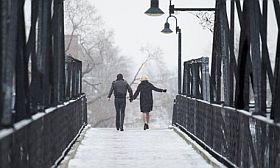


Nastia Tarasova: Linar
Yes, that film blew me away. Actually, it did already around one and a half year ago, when its producer (and camerawoman) Irina Shatalova contacted me asking for general advice on financing and distribution, giving me a pretty dark image of the situation for the creative documentary in Russia. She told me about the film that Nastia Tarasova and she was making about Linar, the wee Russian boy who had undergone a heart transplantation in Italy – after he for almost a year ”had been living with an enormous apparatus on wheels, that constantly piped his blood” (website of the fim). I saw a rough cut and now a couple of months ago Shatalova sent me the finished film.
Which is magnificent, so well made, daring to go the whole way of passion, bombarding the viewer’s emotions while watching a Film that is constantly dramatic in tone, helped by a unique music composition made by Dimitry Selipanov. There are dream sequences, sometimes nightmarish, that you can attach to the situation for the boy, who has to suffer a lot to reach the goal: to get a new heart. But the scenes that for this viewer are most affective are those that catch the daily life for Linar, close to nurses and to ”uncles” = the Russian surgeons, who are with him in Italy. The filmmakers have succeeded in building up a fantastic image of (especially) the young Marcel Tagaev, who (photo) is the one who plays and eats with Linar, and communicates with the mother, who is back home in Russia with two other children. The lovely relationship between the two of them, and the warm but anxious facial expressions of ”uncle Marcel”, whose relationship to Linar is much more than one of patient/doctor, makes the film talk directly (sorry) to your heart! Not to talk about Grandpa Konstantin, the doctor, who comes to Italy after Marcel Tagaev – he picks up Linar from school and walks with him in the streets of Bergamo, where Linar learns to bike, and to count in Italian, which he does upon arrival in airport in Russia. Great scenes are there many of, and you can sense that the filmmakers have been close to Linar and his ”family”. Otherwise you could no achieve such an authenticity.
If any justice exists in the jungle of festivals, this film will have a long and important life all over the world. No surprise that the film got the audience award at a new festival in Omsk, Siberia. It is a film with a huge audience potential.
Russia, 82 mins, 2013.
http://reflexionfilms.com/index.php?option=com_k2&view=item&id=115:linar&Itemid=568
